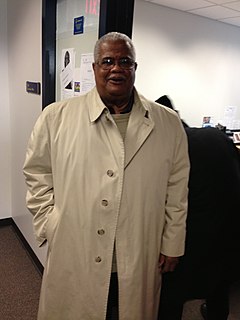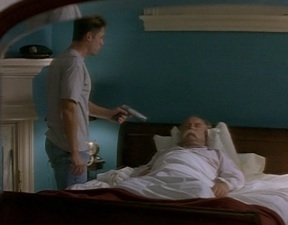Homicide: Life on the Street is an American police procedural television series chronicling the work of a fictional version of the Baltimore Police Department's Homicide Unit. It ran for seven seasons on NBC from January 31, 1993 to May 21, 1999, and was succeeded by Homicide: The Movie (2000), which served as the de facto series finale. The series was originally based on David Simon's book Homicide: A Year on the Killing Streets (1991). Many of the characters and stories used throughout the show were based on events depicted in the book.

David Judah Simon is an American author, journalist, and television writer and producer best known for his work on The Wire (2002–08). He worked for The Baltimore Sun City Desk for twelve years (1982–95), wrote Homicide: A Year on the Killing Streets (1991), and co-wrote The Corner: A Year in the Life of an Inner-City Neighborhood (1997) with Ed Burns. The former book was the basis for the NBC series Homicide: Life on the Street (1993–99), on which Simon served as a writer and producer. Simon adapted the latter book into the HBO mini-series The Corner (2000).

Homicide: A Year on the Killing Streets is a 1991 book written by Baltimore Sun reporter David Simon describing a year spent with detectives from the Baltimore Police Department Homicide Unit. The book received the 1992 Edgar Award in the Best Fact Crime category.

John Munch is a fictional character played by actor Richard Belzer. Munch first appeared on the American crime drama television series Homicide: Life on the Street on NBC. A regular through the entire run of the series from 1993 to 1999, Munch is a cynical detective in the Baltimore Police Department's Homicide unit, and a firm believer in conspiracy theories. He is originally partnered with Det. Stanley Bolander. Munch is based on Jay Landsman, a central figure in David Simon's 1991 true crime book Homicide: A Year on the Killing Streets.

The Baltimore Police Department (BPD) provides police services to the city of Baltimore, Maryland. The department is organized into ten districts; nine geographical and the Public Housing Section. It polices 80.9 square miles (210 km2) of land and 11.1 square miles (29 km2) of waterways. The department is sometimes referred to as the Baltimore City Police Department to distinguish it from the Baltimore County Police Department.

Stanley 'Stan' Bolander is a fictional character in the American crime drama / police procedural Homicide: Life on the Street. He is portrayed by Ned Beatty and appears in the first three seasons and the spinoff film Homicide: The Movie.

The first season of Homicide: Life on the Street, an American police procedural drama television series, originally aired in the United States on NBC between January 31 and March 31, 1993. The show was created by Paul Attanasio, with film director Barry Levinson and television writer and producer Tom Fontana serving as executive producers. Adapted from David Simon's 1991 non-fiction book Homicide: A Year on the Killing Streets, the season followed the fictional detectives of Baltimore Police Department homicide unit and the murder cases they investigate. The show was broadcast on Wednesdays at 9 p.m. EST, with the exception of the series premiere, which aired immediately after Super Bowl XXVII.
Jay C. Landsman is an American retired homicide detective and actor. He was featured in David Simon's 1991 book about the Baltimore homicide unit Homicide: A Year on the Killing Streets. According to the book, Landsman was the last of his family line on the Baltimore Police Department. His brother Jerry was a detective in the agency who left in the 1980s and their father was the department's first Jewish district commander.

Jay Landsman is a semi-fictional character on the HBO drama The Wire based upon the real life Baltimore City police officer Jay Landsman. The fictional character of Jay Landsman is portrayed by actor Delaney Williams.
The Baltimore Police Department plays an integral part in The Wire.
Gary D'Addario is a retired police commander, television technical advisor and actor from Baltimore, Maryland.
Terrence Patrick "Terry" McLarney is a lieutenant assigned to the Baltimore Police Department's Southwestern (8th) District.
Harry Edgerton is a former detective of the Baltimore Police Department. He is notable for his work in the Homicide Unit and on the investigation of drug dealer Melvin Williams with former BPD Detective Ed Burns and the Drug Enforcement Administration. He is notable for working under Sergeant Roger Nolan and Lieutenant Gary D'Addario whose Homicide unit was featured in David Simon's book Homicide: A Year on the Killing Streets. The son of a New York jazz pianist, Edgerton would provide the inspiration for Homicide: Life on the Street character Frank Pembleton, played by Emmy Award winner Andre Braugher.

Oscar "Rick" Requer is a former detective of the Baltimore Police Department.

"Gone for Goode" is the first episode of the first season of the American police drama television series Homicide: Life on the Street. It originally aired on NBC in the United States on January 31, 1993, immediately following Super Bowl XXVII. The episode was written by series creator Paul Attanasio and directed by executive producer Barry Levinson. "Gone for Goode" introduced regular cast members Daniel Baldwin, Ned Beatty, Richard Belzer, Andre Braugher, Wendy Hughes, Clark Johnson, Yaphet Kotto, Melissa Leo, Jon Polito and Kyle Secor.
"Ghost of a Chance" is the second episode of the first season of the American police drama television series Homicide: Life on the Street. It originally aired on NBC in the United States on February 3, 1993. The teleplay was written Noel Behn based on a story by executive producer Tom Fontana, and the episode was directed by Martin Campbell. In it Bayliss begins his investigation into the murder of 11-year-old Adena Watson, Munch and Bolander investigate the unusual death of an elderly man, and Howard insists she is receiving advice about her murder case from a ghost.

"Smoke Gets in Your Eyes" is the eighth episode of the first season of the American police drama television series Homicide: Life on the Street. It originally aired on NBC in the United States on March 24, 1993. In the episode, Howard and Bayliss attempt to quit smoking, Gee discovers secret asbestos removal in the squad room, and Munch and Bolander investigate the beating death of a 14-year-old boy. The episode was written by James Yoshimura and Tom Fontana, and was directed by Wayne Ewing, who doubled as director of photography.
Roger Nolan is a former sergeant of the Baltimore Police Department's Homicide Unit. He is notable for being a Homicide Squad Supervisor, alongside fellow sergeants Terry McLarney and Jay Landsman, under the command of Lieutenant Gary D'Addario, whose work was featured in David Simon's Homicide: A Year on the Killing Streets book. A native of West Baltimore and a former Marine, Nolan joined the department in 1963 working in the State's Attorney's Unit, and the Western, Eastern, and Northwestern Districts, before becoming a supervisor in the department's Homicide Unit.

"See No Evil" is the second episode of the second season of the American police drama television series Homicide: Life on the Street, and the eleventh overall episode of the series. It originally aired on NBC in the United States on January 13, 1994. In the episode, Felton's friend kills his father in an assisted suicide, and Felton tries to convince Lewis to look the other way. In a subplot, Pembleton investigates what appears to be the police shooting of an unarmed suspect.
"Black and Blue" is the third episode of the second season of the American police drama television series Homicide: Life on the Street, and the twelfth overall episode of the series. It originally aired on NBC in the United States on January 20, 1994. In the episode, Pembleton aggressively investigates what he believes to be a police-related shooting. Amid pressure from Gee to pursue civilian suspects, Pembleton elicits a successful confession from an innocent man, leaving Gee feeling conflicted. Directed by Chris Menaul, the episode's teleplay was written by James Yoshimura based on a story by series executive producer Tom Fontana.










